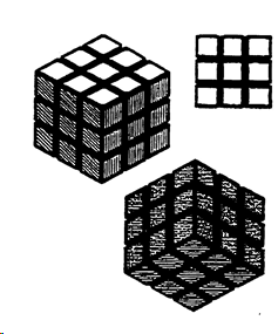Rubik’s Cube trade mark in puzzling General Court decision
Ruling confirms that the ground for refusal may apply even when a graphic representation does not display all the characteristics that allow the goods to perform their function.

In 1999, the three-dimensional (3D) shape, shown below, became a registered trade mark in the EU in respect of “three-dimensional puzzles” in class 28:

Originally registered to Seven Towns Ltd, the mark was transferred to Rubik’s Brand Ltd in 2014.
In 2006, Simba Toys, a competing toy manufacturer, applied to invalidate Rubik’s Brand Ltd’s registration on the ground, inter alia, that it consisted of a shape necessary to achieve a technical result, pursuant to Article 7(1)(e)(ii) of Regulation No 40/94.
The Board of Appeal of the EUIPO (BoA) dismissed the action, following which Simba Toys appealed to the General Court (GC).
In a 2014 decision, the GC upheld the decision of the BoA, taking the view that the technical solution was not attributable to features of the shape itself, but an “invisible” internal mechanism. Simba subsequently appealed.
The CJEU, deciding only on the question of the alleged infringement of Article 7(1)(e)(ii), held that the absolute ground was interpreted too narrowly by the BoA and GC.
According to the CJEU, account should have been taken of non-visible functional elements of the product represented by the shape, such as its rotating capability. The case was referred back to the BoA.
Taking the findings of the CJEU into consideration, the BoA ruled that each of the essential characteristics of the shape was necessary to obtain a technical result.
Rubik’s Brand Ltd appealed the decision and its main ground of appeal was two-fold:
1. The essential characteristics of the mark were incorrectly identified.
2. The intended technical result of the goods was defined too narrowly and the functionality of the essential characteristics was assessed incorrectly.
On 24th October 2019, the GC confirmed the invalidity of Rubik’s Brand Ltd’s trade mark, upholding the earlier decision of the BoA.
Relevant test considered
Turning first to the relevant test, the GC relied upon the decision in Lego Juris v OHIM, C-48/09 P. This case established that the identification of the essential characteristics may be carried out by means of a simple visual analysis of the sign, or a detailed assessment, taking into account relevant criteria such as survey evidence, expert opinions and data relating to earlier intellectual property rights.
Next, the competent authority must ascertain whether the essential characteristics perform a technical function with regard to the goods at issue. This may include consideration of information relating to previous patents, where applicable.
Essential characteristics – an error of judgment?

In the contested decision, the BoA stated that the shape comprised three essential characteristics:
- the overall cube shape;
- the black lines and little squares on each face of the cube;
- the differences in the colours on the six faces of the cube.
Rubik’s Brand Ltd contended that the BoA had erroneously stated that a “reasonably discerning observer” will perceive that one face of the cube shows little squares pictured in white and that the rest of the faces are differently hatched in order to suggest different colours. Further, Rubik’s Brand Ltd criticised the BoA for having concluded that the “differences in colour on the six faces of the cube” represent an essential characteristic of the mark.
The GC held that the BoA made an error in its assessment in concluding that the differences in the colours on the six faces of the Rubik’s cube were discernible from the various hatchings in the graphic representation.
The GC observed that it is not possible to detect, from a simple visual analysis of the graphic representation of the mark, the presence of colour variations. In addition, Rubik’s Brand Ltd did not claim any colour indications or references to such in the mark description.
However, the GC found that the BoA’s error of judgment did not affect the legality of its decision in finding that the essential characteristics, namely the overall cube shape and black lines and little squares, are necessary to obtain a technical solution.
Intended technical result
In the context of the intended technical result of the goods, the GC confirmed the validity of the BoA’s definition, namely: “rotating rows of cubes in order to gather them in the right colours on the six faces of the puzzle”. According to the GC, the Court correctly observed that the shape represents the goods for which registration is sought: the 3D Rubik’s Cube puzzle.
Functionality
As to the allegation that the BoA had incorrectly assessed the functionality of the essential characteristics, the GC upheld the BoA’s finding that the cube shape and black lines dividing the cube into smaller cubes cannot be separated from the function of the goods. The black lines represent a physical separation of the smaller cubes, which is necessary to rotate the rows of cubes by means of an internal central mechanism.
The GC stipulated that Article 7(1)(e)(ii) may apply even if the graphic representation does not reveal all the elements necessary for the implementation of the technical solution.
The GC stipulated that Article 7(1)(e)(ii) may apply even if the graphic representation does not reveal all the elements necessary for the implementation of the technical solution. As long as the essential characteristics in the mark representation can be shown to be indispensable to obtaining the technical solution, the shape will be caught by the absolute ground for refusal. The GC warned that this was a necessity. Otherwise, the provision would be easily circumvented by a shape whose graphic representation omits certain functional characteristics.
Public interest case reiterated
Finally, the GC dismissed Rubik’s Brand Ltd’s argument that the existence of alternative geometrical shapes capable of fulfilling the same function was a relevant consideration in the assessment of the intended technical result and functionality of the essential characteristics.
Recalling the rulings in Philips v OHIM, C-299/99 and Lego, the GC reiterated the public interest underlying the absolute ground for refusal of shapes necessary to achieve a technical result. In essence, granting registration of a shape as a trade mark is likely to allow the proprietor to prevent other undertakings not only from using the same but similar shapes. The consequence is a monopoly that would render a significant number of alternative shapes unusable.
Inconsistency of interpretation
The Rubik's Cube saga reflects inconsistencies in the Courts' interpretation and application of the absolute ground for refusal of shapes which are necessary to achieve a technical result.
The takeaway point from this latest ruling is that functional elements of the goods that are not visible will not preclude the Court from finding that the essential characteristics, revealed in the graphic representation, are necessary to obtain the intended technical result of the goods – even if they are not sufficient themselves to achieve that purpose.
Key points:
- Where not all the features of a 3D shape contributing to the intended technical solution of the goods are present in the mark representation, Article 7(1)(e)(ii) may still apply.
- Design freedom is irrelevant in the context of assessing the intended technical result and functionality of the essential characteristics.
- Colour differentiations cannot be assumed from hatchings in mark representations, particularly where no colour indications have been claimed or referred to in the mark description.
Read more case comments
Is that coffee from Iceland?
An EU General Court decision reinforces the barriers to registering country names as EU trade marks, writes David Birchall. T-105/23, Iceland Foods Ltd v EUIPO, General Court.
Uneven footing
Post-sale circumstances can be considered when assessing similarity and likelihood of confusion, writes Leanne Gulliver. [2025] UKSC 25, Iconix Luxembourg Holdings SARL v Dream Pairs Europe Inc & Anor.
A bad beginning makes a bad ending
A trade mark registered in bad faith may be challenged without any time limit, writes Eve Duggan. C-322/24, Sánchez Romero Carvajal Jabugo SAU v Embutidos Monells SA, CJEU, Eighth Chamber.
Notting Hill-gate
Failure to deal with IP before a corporate restructure led to handbags at dawn over the use of a logo, says Chris Morris. [2025] EWHC 1793 (IPEC), Courtnay-Smith & Anor v The Notting Hill Shopping Bag Company Ltd & Ors.
Not so easy
Rose Smalley-Gordon reviews two conflicting High Court decisions, resolved on appeal. [2025] EWCA Civ 946, easyGroup Ltd v Easy Live (Services) Ltd & Ors; [2025] EWCA Civ 1000, easyGroup Ltd v easyfundraising Ltd & Ors.
Not a valid replacement
A prosthetic-knee-joint maker filed EU trade marks to extend an expired patent in bad faith, reports Geoff Weller. C-17/24, CeramTec GmbH v Coorstek Bioceramics LLC, CJEU.







